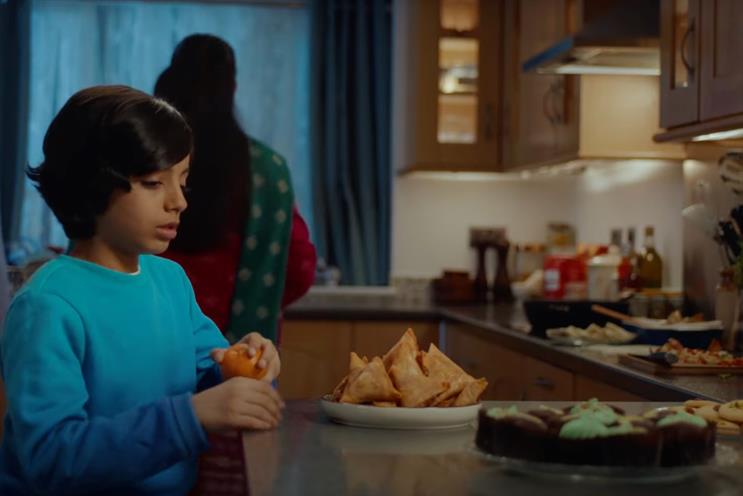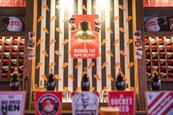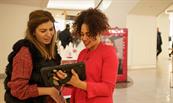
Last week, Campaign published an opinion article by Arif Miah, creative director of Mud Orange, who, putting it mildly, was not the biggest fan of Tesco's Eid ad.
"Alia's 'worth the wait' samosas" by Bartle Bogle Hegarty was, for Miah at least, "terrible" and "half-arsed" on "so many levels". His piece went on to take issue with various aspects of the ad, from perceived stereotyped casting and imagery to technical shortcomings.
Tesco and its agency declined to comment at the time but agreed to be part of this follow-up analysis.
Alessandra Bellini, Tesco's chief customer officer, tells Campaign the brand is "committed to representing and championing our brilliant and diverse communities, customers and colleagues – whether that means challenging stereotypes and countering underrepresentation or celebrating the cultures and differences that make us who we are".
Bellini explains how Tesco worked with "practising Muslims at every step of the way – including director Sasha Nathwani". She says the spot "resonated well with the communities it was there to represent whilst sharing some of the magic of Eid with a wider audience".
"There is always room to improve and learn and we're pleased to see the industry having important conversations that can help us all to do the best job we can as businesses and advertisers," she adds.
Clearly, many are having such conversations. For Dino Myers-Lamptey, The Barber Shop founder, who worked with the Advertising Standards Authority on its Racial Stereotyping in Advertising report, "it's all too easy to generalise in advertising".
He admits this is "generally OK when you're representing majority audiences, who are regularly portrayed in the full spectrum of ways", but adds: "When it comes to minority groups, the infrequency of that appearance means it represents much more, and makes more of a statement about the role and 'way of life' from those portrayed."
His research in conjunction with the ASA unearthed a major insight – there are "so many intersections that will see the same character portrayal differently... religion, generation, gender and continent means the nuances are much more noticeable than you think".
Myers-Lamptey says: "Demographic targeting leads to generalisations, which lead to stereotypes, some may be considered harmless, and others harmful."
Tried and tested
Tesco points out that while the campaign relied on elements of creative licence and imagery, Muslim groups and representatives were consulted with closely. The Green Lane Mosque in Birmingham, which is featured in the campaign, wrote to Tesco after seeing the ad to thank the retailer for raising awareness of Eid, Tesco consulted its own race and ethnicity network and all of the cast had "lived experience" of celebrating Eid al-Fitr.
The ad was rigorously tested internally and externally, according to Asad Dhunna, the chief executive and founder of The Unmistakables, a diversity and inclusion consultancy that worked with Tesco and BBH on the ad. He says that some of the moments and aspects of the ad "such as the shoes [known as khussas, an aspect Miah found clichéd] in the hallway, resonated highly".
"Other moments – such as the styling and food choices – were creative decisions that were led by, or made in consultation with, a number of Muslims," Dhunna says.
But Myers-Lamptey argues that a number of individuals "can't represent entire ethnicities of religious groups across continents and generations".
"You have to have the teams, yes, and they have to have the permission to challenge the details, but you also need a wide enough group of consumers to validate the work."
He questions whether that process took part at the "right stages, or whether the feedback was really heard, as [Miah] makes a lot of good points", points that "could have made good work greater".
"This ad doesn't cause harm or offence, but it could have been even greater."
Artistic licence
Miah's piece highlighted several technical points he perceived as problematic, including the apparent mistiming of the Eid meal and a crescent moon signifying Eid's start being a C-shape rather than a backwards C, as it appears in the Northern Hemisphere.
While the moon's depiction was a technical oversight that has since been corrected in the editing suite, some stylistic choices were apparently made.
Sol Ghafoor, director of strategic services at AnalogFolk London, says the ad was "done well and made me smile when I saw it", but he acknowledges: "Where perhaps some artistic licence has been taken, is the actual sequence of events for Eid, which means that for some people who have a lived experience of this, some of the richness of this cultural and religious moment was lost in translation...
"But I am glad that as a first step, we're seeing representation and acknowledgment of Eid in ads. We should tell more Eid stories."
For a mainstream brand looking to reach a swathe of consumers, some degree of stereotyping is, arguably, inevitable. But the nature and context of such tropes is crucial.
Miah said the art direction appeared to have been "conjured up from a mood board of scenes from East is East, Goodness Gracious Me, and Citizen Khan – caricatures of British Muslim life but far from the dynamic realities".
He also criticised the "choice of casting and styling to the sound design, it just feels like an ambiguous South Asian family with no real nod to British Muslim culture".
Dhunna disagrees, arguing that British Muslim culture is "like any culture, not a singular homogenous thing".
"To try and convey the reality of four million people's experience in just 30 to 40 seconds would be impossible, especially when Eid ads in the UK are still quite rare. When some communities aren't used to seeing something so visible that's deeply based in their culture, they are more attuned to finding flaws in search of perfection."
Dhunna asserts that the ad was neither culturally insensitive nor clumsy in execution and that the debate the ad has stirred up is largely positive.
"Some people said it's 'too Muslim' and such visible advertising around Eid has no place in the UK," he adds. "Others said it's 'not Muslim enough' and that it didn't cover the vast and nuanced experiences of Eid."
Myers-Lamptey says Miah is not wrong, that the ad is a "stereotype of work that tries to be inclusive" via its pointed attempt at broad appeal.
But Ghafoor doesn't agree it was stereotyping. "East is East and Goodness Gracious Me are quite extreme if you go back and watch them," he notes. "I didn't sense any of that. Khussas are worn on Eid by some people, others might wear the latest pair of Nike Air Jordans. We should be proud of these. The problem is when you pick up on one facet of a culture and tradition and not others it can seem like stereotyping."
No 'silver bullet'
For Dhunna, there is no silver bullet: "Brand advertising at this scale has to work for a number of audiences and try to appeal to as broad a base as possible in order to be effective. Finding the balance between representing a minority audience, while also resonating with a mainstream audience, requires careful thought to ensure portrayals are nuanced rather than novel."
Ghafoor adds that inclusivity is not just about including people but about "getting to know them, understanding and appreciating their culture more deeply and telling these surprising or hidden stories", but he accepts that's a complex thing to achieve.
"I think the ad attempts to do this with the moon sighting, as it's a key moment. However, in a 30 to 40-second ad, it's difficult to go deeper. Let's also not forget that the ad is trying to sell product also, so there are a few balls to juggle."
Onus on us all
Dhunna welcomes criticism, challenge and debate, saying "we all have a responsibility to create more culturally nuanced advertising for all audiences". He adds: "Our hope is that conversations like this will spark ideas and opportunities for years to come rather than put people off from even trying."
But Chloë Davies, head of social impact at Lucky Generals points out that while it's important to "recognise often underrepresented communities in our work, it's imperative to make sure that there is substance behind any demographic targeting".
Davies has a long track record of working for D&I causes – before joining the agency she was head of training and engagement at Mygwork, a recruitment and networking hub for LGBT+ students, graduates and professionals, and she holds voluntary positions including head of finance and governance for UK Black Pride.
"In recent examples of work like this, whilst being well received generally, there have still been many questions raised on authenticity, stereotyping and whether there was enough input from those diverse communities at the ideation and creative stages," she says.
Karen Martin, chief executive of BBH London, insists that while the agency "strongly believe it is our job to ensure advertising represents all cultures", "we will be taking learnings on board for the next year".
She adds: "We are wholly committed to making sure we are challenging stereotypes and making underrepresented cultures and communities feel represented, and we’ll continue to do that."
Davies argues that change must be fostered from within an ad industry that is more deeply representative of the UK's cultural make-up, "having an agency or organisation that is culturally diverse, that taps into all identities inside your house, or at least has the mechanisms and routes to tap into and engage with those communities outside their doors".
This approach should span "working in collaboration with, learning from and building that into your work from the ideation stage, through to strategy, brief, creative and production rather than needing to rely on quotas and tickboxing".
Ghafoor concurs. "Remember that an ad is tied to a business objective: to sell product, change perception et cetera," he says. "Striking a balance between that, whilst also telling the authentic story of a minority group, is a delicate balance."
The variation of opinion Tesco's ad has sparked is telling. Achieving balance is no easy task but the fact that conversations around DEI are so fluid is a testament to how the ad industry is on a journey towards greater inclusivity, even if it's still short of the destination.





copy-2.jpg)